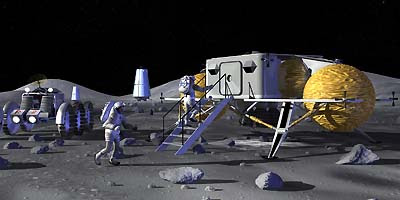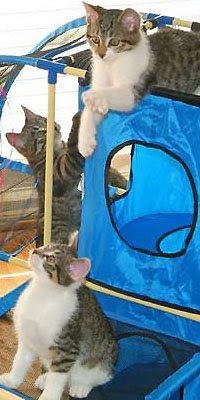 Earlier this month NASA announced plans to construct a base at one of the moon's poles. The poles are in near constant sunlight, which will allow for solar power generation at the base.
Earlier this month NASA announced plans to construct a base at one of the moon's poles. The poles are in near constant sunlight, which will allow for solar power generation at the base.Construction will begin in 2020 with 4-person crews making 7-day visits to the moon until a functional base is completed in 2024. After that the base would be continually manned with rotating crews similar to how the International Space Station operates.
Before that, NASA will develop a new spaceship, the Crew Exploration Vehicle (CEV). The CEV will be shaped like the Apollo capsules but 3 times larger. It should be ready by 2010 and will replace the current space shuttle fleet. When the CEV returns to earth it will deploy three parachutes and set down on dry land.
Next, NASA will develop a lunar lander. The lander and the CEV will be put into Earth's orbit separately. They will attach in space before making the 3 day trip to the moon. In the moon's orbit the Lander and the CEV will detach with the lander going to the moon's surface.
More at NASA: The Vision for Space Exploration

 Last May, papers on Rhodnius Prolixus by Dr Gary Chiang,
Last May, papers on Rhodnius Prolixus by Dr Gary Chiang,  Copy Cat, the world's first cloned cat, has had a litter of three kittens. The kittens were born in September and appear healthy. However, Copy Cat is not the first cloned cat to give birth. In New Orleans, two cloned wild African cats successfully mated to produce kittens.
Copy Cat, the world's first cloned cat, has had a litter of three kittens. The kittens were born in September and appear healthy. However, Copy Cat is not the first cloned cat to give birth. In New Orleans, two cloned wild African cats successfully mated to produce kittens. A report in today's Science magazine extrapolates that the Ebola virus has killed more than 5000 gorillas in West Africa. Ebola could be a more important factor in the decline of great apes (by almost 50%) across central Africa in the last two decades than the bushmeat trade or deforestation. The basis of the report was a study of a group of western gorillas in the Lossi Sanctuary in northwest Republic of Congo.
A report in today's Science magazine extrapolates that the Ebola virus has killed more than 5000 gorillas in West Africa. Ebola could be a more important factor in the decline of great apes (by almost 50%) across central Africa in the last two decades than the bushmeat trade or deforestation. The basis of the report was a study of a group of western gorillas in the Lossi Sanctuary in northwest Republic of Congo. The
The